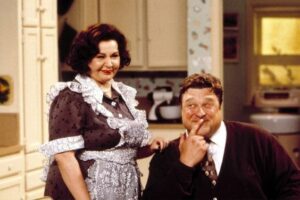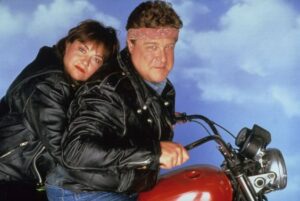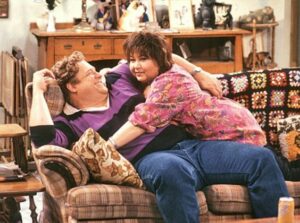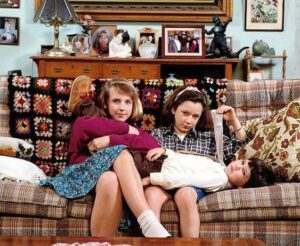
“Roseanne” was the antidote to the 1980s sitcom family.
The decade was full of productions depicting affluent, well-groomed, loving units. It seems appropriate that “All in the Family” and “Good Times” both signed off in 1979, because primetime television would change dramatically during Ronald Reagan’s two-term presidency. Working-class characters disappeared (with a few exceptions, like the spin-off “Archie Bunker’s Place”) and were replaced by visions of upper middle class.
Even the era’s prevailing image of a black family, a subject the medium usually made sympathetic to reduced means, was the Huxtables of “The Cosby Show”, a family as successful, educated, and comfortable as any on television. Other popular TV dynamics — the Keatons of “Family Ties”, the Seavers of “Growing Pains”, the Tanners of “Full House” — similarly featured large houses and relatively small problems.

Then, “Roseanne” premiered in the fall of 1988. Built around its namesake, Roseanne Barr, and adapted from her popular stand-up comedy, this traditional multi-camera sitcom took a starkly different approach to portraying life in a modern American family. The Conners of Lanford, Illinois are a true, unglamorous working-class clan. The heads of the household, Roseanne (Barr) and Dan (John Goodman), were high school sweethearts. Neither attended college. Now married fifteen years, they are decidedly fat and unhappily employed. Roseanne works hard on a factory line for Wellman Plastics. Beer-swilling Dan is a construction contractor. Their house is dirty and kitschily decorated. In other words, it has that believably lived-in quality most sitcom sets lack.
Roseanne and Dan’s children number three. Eldest Becky (Lecy Goranson) is at the beginning of her teen years, a period marked by vanity, heavy telephone use, and interest in the opposite sex (specifically, a recurring Jared Rushton of Big and Honey, I Shrunk the Kids fame). All of that contrasts with middle child Darlene (Sara Gilbert), a sardonic tomboy. Rounding out the pack is youngest son D.J. (Michael Fishman), a typical boy, a bit mischievous and forgivably naïve. Often showing up at the Conner house, to Dan’s irritation, is Roseanne’s younger sister and co-worker Jackie (Laurie Metcalf).
The Conners and Jackie watch coverage of the tornado that brought them closer together.
It might surprise you to learn that the people behind “Roseanne” were the same people behind “The Cosby Show.” Two of the executive producers were Marcy Carsey and Tom Werner, who were the showrunners on “Cosby” and its collegiate spin-off “A Different World.” The third, series creator Matt Williams, wrote nearly twenty episodes from the first four “Cosby” seasons and the pilot for “A Different World.”

Though “Roseanne” was on a different network (ABC) and night (Tuesday) than the other two (which were the foundation of what would become NBC’s “Must See TV” block), it immediately achieved comparable success. In fact, “Cosby” and “Different” had ranked #1 and 2 overall by Nielsen ratings in the 1987-88 season. In its first year on the air, “Roseanne” landed in between them, claiming the second biggest audience on television with an average estimated audience of 21.5 million viewers, a number unheard of for all but “American Idol”, “Dancing with the Stars”, and “Sunday Night Football” these more populous days.
Along with its sky-high ratings, the series drew some critical acclaim. Although it was not recognized on the order of “The Cosby Show”, “Roseanne” nonetheless became a fixture in certain awards shows. It unsurprisingly won Favorite New TV Comedy Program in the 1989 People’s Choice Awards. The same year, both Barr and Goodman won American Comedy Awards and were nominated for Golden Globes. The show lost the Best TV Series (Comedy/Musical) Golden Globe to defending champion “The Wonder Years.” The first season also picked up four Emmy nominations, Goodman for Outstanding Lead Actor and three technical category nods. It lost all of those, something Goodman would get used to as he was nominated and lost the Emmy for each of the show’s first seven seasons. (He finally picked up a Guest Actor in a Drama Series statue for “Studio 60 on the Sunset Strip”, the only major honor bestowed on that one-season Aaron Sorkin show.)
Dan (John Goodman) sees a lot more of Jackie (Laurie Metcalf) at his house than he would like to, or so says the running gag. Before he became a star of “ER” and leading man of film, George Clooney held a recurring role as Roseanne’s boss Booker Brooks.
On the other hand, maybe it shouldn’t surprise you that “Roseanne” was a Carsey-Werner production. Like “Cosby”, it supplied heart and humor, only here the heart is dipped in humor. The Conners’ love is masked in sarcasm, a trademark of Barr’s comedy. The matriarch can joke about wanting to get rid of her kids and often openly badmouth Dan, but both the family and the families watching would never hesitate to identify the house as a loving and compassionate environment. The show’s characters just rarely state or recognize that outright.

But viewers took comfort in the show all the same, if not the most entertaining of sitcoms than at least one of the more authentic and less sentimental ones of its time.
The first season of “Roseanne” features one of today’s biggest movie stars (by media mentions more than commercial success) in a recurring role. Twenty-seven-year-old George Clooney plays Booker Brooks, Roseanne’s boss at Wellman and Jackie’s boyfriend. Clooney had already put in a year on the unrenewed Elliott Gould hospital sitcom “E/R” and spent two seasons recurring on “The Facts of Life.” He was still six years away from his star-making role on NBC’s “ER” and another two from feature film clout. An established movie star of the time, Bruce Willis, then in the final season of his TV show “Moonlighting”, shows up unbilled in an end credits sequence.
Distributing their own series has made Carsey and Werner rich beyond almost anyone’s wildest dreams. In 2005, Werner’s net worth was pegged at $852 million, $600 M of which, according to Wikipedia, stem from selling “The Cosby Show” into syndication. Early last decade, Carsey’s net worth was estimated at $600 M.
For fans, a less positive aspect of the independent distribution has been in the unreliable DVD releases of the company’s hit sitcoms. Like many studios, Carsey-Werner dragged their feet at making their shows available to own. Fox started releasing “That ’70s Show” to disc in 2004, well after that recent sitcom had entered syndication. The older entries in the Carsey-Werner catalog started turning up the following year from Anchor Bay, just catching the end of the catalog TV-on-DVD boom. Flagship series “The Cosby Show” would first be handled by Urban Works, then First Look Studios. No matter which company’s name adorned the releases, many of the catalog entries’ earliest DVDs were plagued by only offering the abbreviated cuts produced for syndication, which lopped off as many as four minutes of show to accommodate modern commercial breaks. Fortunately, the issue was corrected for future seasons (but not before some unsavory spin control).
With the Anchor Bay DVDs discontinued, “Roseanne” is one of four Carsey-Werner series whose home video rights were recently acquired by Mill Creek Entertainment (the others being “’70s Show”, “3rd Rock from the Sun”, and “Grounded for Life”). In typical Mill Creek fashion, the discs are packed tightly, a little more tightly than most other studios would. Also in typical Mill Creek fashion, the new DVDs are remarkably low-priced. The Complete First Season of “Roseanne” holds 23 episodes on three discs and carries a suggested retail price of just $14.98 (and you’ll usually pay at least a few dollars less than that).
Though Mill Creek has traditionally been known more for value than for customer satisfaction, this reissued set confirms you’ll get both here with the cover art boasting “The Complete, UNCUT original broadcast edits of all 23 season one episodes!” The DVD lives up to that promise, with episodes running anywhere from two to four minutes longer than their previous DVD presentations. The long opening and closing credits sequences are intact, as are the multitude of establishing shots.
For this review, I chose to watch twelve of the 23 featured episodes. They are the ones synopsized below.
Roseanne and Dan aid an injured Darlene in the pilot episode “Life and Stuff.” Though no guns are drawn, Walter Sobchak still gets into bowling in “Lovers Lane.” The Conner kids treat Dan to a giant birthday breakfast.

Disc 1
1. Life and Stuff (25:41) (Originally aired October 18, 1988)
On a typical busy day, Roseanne has to leave work early to meet with Darlene’s history teacher. The role of D.J. is played by Sal Barone in this pilot and the opening credits sequence that precedes it.
2. We’re in the Money (24:21) (Originally aired October 25, 1988)
3. D-I-V-O-R-C-E (24:23) (Originally aired November 1, 1988)
4. Language Lessons (24:19) (Originally aired November 22, 1988)
5. Radio Days (24:17) (Originally aired November 29, 1988)
6. Lovers Lane (24:22) (Originally aired December 6, 1988)
7. The Memory Game (24:22) (Originally aired December 13, 1988)
Dan is excited for the Conners to take a professional family photo for a high school classmate’s project. It leads Roseanne and Dan to reflect on the past and reveal a big secret from the week they were broken up.
8. Here’s to Good Friends (24:19) (Originally aired December 20, 1988)
Roseanne and Jackie comfort Crystal (Natalie West) after she gets dumped.
9. Dan’s Birthday Bash (23:37) (Originally aired January 3, 1989)
Roseanne and Dan fight over him almost getting into a fight at his Lobo Lounge birthday celebration.
Mother (Roseanne Barr) and daughter (Sara Gilbert) share a tender moment in “The Monday Thru Friday Show.” Ned Beatty guest stars as Dan’s contentious
dad Ed in “Father’s Day.” The dress Becky (Lecy Goranson) wants in “Mall Story” is out of the Conners’ price range.
Disc 2
10. Saturday (24:21) (Originally aired January 10, 1989)
Dan’s sexist friend Dwight (William Sadler) has the hots for Jackie.
11. Canoga Time (23:58) (Originally aired January 17, 1989)
12. The Monday Thru Friday Show (24:07) (Originally aired January 24, 1989)
Roseanne and Dan plan to take the honeymoon they never had, but they can’t agree on a destination. Meanwhile, Becky refuses to dissect a frog, and Darlene gets fired from her newspaper route.
13. Bridge Over Troubled Sonny (24:19) (Originally aired January 31, 1989)
14. Father’s Day (23:51) (Originally aired February 7, 1989)
Dan dreads a visit from his judgmental, tale-telling father (Ned Beatty).
15. Nightmare on Oak Street (23:51) (Originally aired February 14, 1989)
16. Mall Story (22:24) (Originally aired February 21, 1989)
The Conners hit the mall as Becky looks for a dress and Dan buys shoes.
17. Becky’s Choice (23:34) (Originally aired February 28, 1989)
18. The Slice of Life (23:21) (Originally aired March 7, 1989)
Darlene has a health scare, throwing Roseanne and Dan into worry.
Dan and Roseanne feel a storm coming on in “Toto, We’re Not in Kansas Anymore.” “Death and Stuff” mines laughs from a corpse, foreshadowing the imminent release of “Weekend at Bernie’s.” Before he was a Republican presidential candidate, Fred Dalton Thompson supervised Roseanne Conner in a plastics factory.
Disc 3
19. Workin’ Overtime (23:47) (Originally aired March 14, 1989)
20. Toto, We’re Not in Kansas Anymore (23:44) (Originally aired March 28, 1989)
The Conners take shelter during a fierce tornado.
21. Death and Stuff (23:20) (Originally aired April 11, 1989)
A door-to-door salesman dies in the Conners’ kitchen, leaving the family to cope with the body until the coroner arrives.
22. Dear Mom and Dad (23:45) (Originally aired April 18, 1989)
23. Let’s Call it Quits (23:09) (Originally aired May 2, 1989)
Roseanne stands up to the factory’s demanding new supervisor (2008 presidential candidate Fred Thompson).
Roseanne (Roseanne Barr) and Dan (John Goodman) share a rare relaxing moment together. Darlene (Sara Gilbert) and Becky (Lecy Goranson) are like night and day, but they both appreciate a breakfast morning radio listen when it means a potential school closing.

Per its original methods, “Roseanne” is presented in 1.33:1 fullscreen and Dolby 2.0 stereo sound here. Packing over three and a half hours of video on Discs 1 and 2 with space to spare results in a low bit rate, but the picture quality remains pretty good, almost as good as can be expected of a late-’80s sitcom. I did spot a few instances of unfortunate momentary video glitches, in which color patterns filled the screen for a few frames. In addition, the soft-lit pilot is a tad blurry and “Bridge Over Troubled Sonny”, seemingly sourced differently than the rest, is quite unsightly. Otherwise, there were few concerns unique to this. The soundtrack is standard late-20th century sitcom, clear and intelligible throughout but you never feel like the Conners are right there in your house. No subtitles are offered, but closed captions are, for those who can easily access them (and that excludes those with HDMI connections). I was able to get them to show up on only of my two DVD-ROM programs. They shorten exchanges pretty noticeably.
Roseanne Barr doesn’t mince words in her candid but not that new interview. John Goodman has had a solid film career, especially in Coen Brothers movies and cartoons, but he still finds time to take a look back at his star-making sitcom.
Mill Creek retains almost all of the fine bonus features from the 2005 Anchor Bay DVD. The only omissions are the four episode introductions from Roseanne.
“Roseanne on ‘Roseanne’: A New Candid Interview” (9:00) features retrospective remarks from the star, creative consultant, and eventual executive producer. This warm, insightful reflection is spiced up with behind-the-scenes footage and show clips from all over the nine-season run.
“John Goodman Takes a Look Back” (7:00) relies more heavily on show clips, but the actor also has some good memories to share.
A statement Roseanne makes to Dan’s father qualifies as the domestic goddess’ sagest piece of wisdom. John Goodman, Roseanne Barr, and Alicia Goranson horse around in the Bloopers reel.
“Wisdom from the Domestic Goddess” (5:15) is a montage of familial Roseanne barbs from Season One, concluding with a countdown of her top five pearls of wisdom.

“Bloopers” (11:00) hail from the early seasons, boast the picture quality of the show itself, and bleep profanity.
Finally, as you’d guess, “Season One Highlights” (6:20) is a reel of highlights from the season, seemingly arranged by airdate. I guess this is what you watch if you want to relive the full season in the time to takes to watch a q
uarter of an episode.
Roseanne gives herself scary eyes in the ethereal montage of the DVDs’ main menu. Roseanne’s meeting with Darlene’s history teacher appears when the first episode is highlighted on Disc 1’s menu.
Episodes are broken into four chapter stops timed to commercial/act breaks,
enabling easy skipping of the opening and end credits.
The main menu plays blue-tinted clips in the empty space left by the reformatted cover artwork and a looped excerpt of the theme music. Episode menus are slow to navigate, but that is forgiven on account of the nice design that shows one large image from the episode you have highlighted.
Packaging is one area where this release leaves room for improvement. The case is slightly wider than a standard DVD keepcase, which is fine, but inside, we find not swinging trays or multiple hubs but paper/plastic envelopes, one holding each disc, stacked and held securely in a bordered section. The word “cheap” springs to mind, but hey, when you’re getting a complete season set for around $10, who can complain? The envelopes should keep out dust, prevent scratches, and stay in place, plus the outside case is sturdy and standard, no indication of the cost cuts inside. Though the disc labels repeat the cover artwork, they gladly list the episodes included on each platter.
Dan (John Goodman) and Roseanne (Roseanne Barr) look it over in their kitchen. The Conners fall one blink shy of a perfect family photo.
I’ve always considered “Roseanne” middle-of-the-road as far as sitcoms of the ’80s and ’90s go and time hasn’t changed that view. The show entertains reliably, without endearing me to the same degree that many of the era’s other popular family comedies have.
Still, the generally high quality presentation, very good extras, and super low price make Mill Creek’s DVD easy to recommend for fans and even for the unacquainted who think they could become fans. It’s too bad Roseanne’s handful of episode intros have been dropped, but restoring the broadcast cuts is far more important. A few brief video glitches, a lack of subtitles, and unconventional packaging should do little to stand in the way of viewer satisfaction here.
